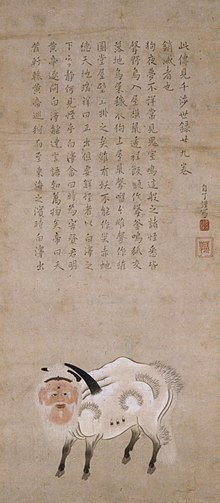Gusukuma Seihō: Difference between revisions
Curly Turkey (talk | contribs) →top: dates on Wikipedia are given in Gregorian |
Rescuing 1 sources and tagging 0 as dead. #IABot (v1.6beta3) |
||
| Line 3: | Line 3: | ||
'''{{Nihongo|Gusukuma Seihō|城間 清豊|extra=19 November 1614 – 16 November 1644<ref>Gusukuma was born and died on the 18th day of the 10th month on the [[lunar calendar]]. These dates correspond to 19 November 1614 and 16 November 1644 on the [[Gregorian calendar]].</ref>}}''' was an official [[court painter]] at the royal court of the [[Ryūkyū Kingdom]]. He was also known as Ji Ryō (自了) and by the [[Okinawan family name|Chinese-style name]] Qin Kesheng (欽可聖, J: Kin Kasei).<ref name=kotobank>"[http://kotobank.jp/word/%E5%9F%8E%E9%96%93%E6%B8%85%E8%B1%8A Gusukuma Seihô]." Kotobank.jp. Accessed 6 October 2009.</ref> |
'''{{Nihongo|Gusukuma Seihō|城間 清豊|extra=19 November 1614 – 16 November 1644<ref>Gusukuma was born and died on the 18th day of the 10th month on the [[lunar calendar]]. These dates correspond to 19 November 1614 and 16 November 1644 on the [[Gregorian calendar]].</ref>}}''' was an official [[court painter]] at the royal court of the [[Ryūkyū Kingdom]]. He was also known as Ji Ryō (自了) and by the [[Okinawan family name|Chinese-style name]] Qin Kesheng (欽可聖, J: Kin Kasei).<ref name=kotobank>"[http://kotobank.jp/word/%E5%9F%8E%E9%96%93%E6%B8%85%E8%B1%8A Gusukuma Seihô]." Kotobank.jp. Accessed 6 October 2009.</ref> |
||
Gusukuma was born to an aristocratic family in [[Shuri, Okinawa|Shuri]]. His father was a musician, but Gusukuma was born [[deafness|deaf]]<ref name=arts>"[http://www.wonder-okinawa.jp/013/E/art/dynasty/art10.html Hakutaku no zu]." Arts of Okinawa. Okinawa Prefectural Government. 2003. Accessed 6 October 2009.</ref> and he focused his energies in a different direction, teaching himself to paint.<ref name=jinmei>"Ji Ryô." ''Okinawa rekishi jinmei jiten'' (沖縄歴史人名事典, "Encyclopedia of People of Okinawan History"). Naha: Okinawa Bunka-sha, 1996. p 44.</ref> He sought out [[Chinese painting]]s, and was heavily influenced by them.<ref name=kotobank/> |
Gusukuma was born to an aristocratic family in [[Shuri, Okinawa|Shuri]]. His father was a musician, but Gusukuma was born [[deafness|deaf]]<ref name=arts>"[http://www.wonder-okinawa.jp/013/E/art/dynasty/art10.html Hakutaku no zu] {{webarchive|url=https://web.archive.org/web/20090909180229/http://www.wonder-okinawa.jp/013/E/art/dynasty/art10.html |date=9 September 2009 }}." Arts of Okinawa. Okinawa Prefectural Government. 2003. Accessed 6 October 2009.</ref> and he focused his energies in a different direction, teaching himself to paint.<ref name=jinmei>"Ji Ryô." ''Okinawa rekishi jinmei jiten'' (沖縄歴史人名事典, "Encyclopedia of People of Okinawan History"). Naha: Okinawa Bunka-sha, 1996. p 44.</ref> He sought out [[Chinese painting]]s, and was heavily influenced by them.<ref name=kotobank/> |
||
Hearing of the young painter, King [[Shō Hō]] called him to his court, and bestowed upon him the name Ji Ryō. It is said that the [[Chinese investiture envoys to Ryukyu|Chinese investiture envoys]] who witnessed his painting compared him to some of the top painters in China, and that [[Kanō Yasunobu]], court painter for the [[Tokugawa shogunate]], similarly praised the artist when one of Gusukuma's works was brought to [[Edo]] by the 1634 [[Ryukyuan missions to Edo|Ryukyuan envoy]].<ref name=arts/><ref name=jinmei/> |
Hearing of the young painter, King [[Shō Hō]] called him to his court, and bestowed upon him the name Ji Ryō. It is said that the [[Chinese investiture envoys to Ryukyu|Chinese investiture envoys]] who witnessed his painting compared him to some of the top painters in China, and that [[Kanō Yasunobu]], court painter for the [[Tokugawa shogunate]], similarly praised the artist when one of Gusukuma's works was brought to [[Edo]] by the 1634 [[Ryukyuan missions to Edo|Ryukyuan envoy]].<ref name=arts/><ref name=jinmei/> |
||
Revision as of 12:48, 26 October 2017

Gusukuma Seihō (城間 清豊, 19 November 1614 – 16 November 1644[1]) was an official court painter at the royal court of the Ryūkyū Kingdom. He was also known as Ji Ryō (自了) and by the Chinese-style name Qin Kesheng (欽可聖, J: Kin Kasei).[2]
Gusukuma was born to an aristocratic family in Shuri. His father was a musician, but Gusukuma was born deaf[3] and he focused his energies in a different direction, teaching himself to paint.[4] He sought out Chinese paintings, and was heavily influenced by them.[2]
Hearing of the young painter, King Shō Hō called him to his court, and bestowed upon him the name Ji Ryō. It is said that the Chinese investiture envoys who witnessed his painting compared him to some of the top painters in China, and that Kanō Yasunobu, court painter for the Tokugawa shogunate, similarly praised the artist when one of Gusukuma's works was brought to Edo by the 1634 Ryukyuan envoy.[3][4]
Most of Gusukuma's works were destroyed in the 1945 battle of Okinawa. There is only one extant work which bears a Seal (rakan) confirming it to have been painted by Gusukuma.[3][4] It is held by the Okinawa Prefectural Museum, has been designated an Okinawa Prefectural Important Cultural Property, and depicts a fantastic creature known as bai ze in Chinese and hakutaku in Japanese.[3]
References
- "Ji Ryô." Okinawa konpakuto jiten (沖縄コンパクト事典, "Okinawa Compact Dictionary"). Ryukyu Shimpo. 1 March 2003. Accessed 6 October 2009.
- ^ Gusukuma was born and died on the 18th day of the 10th month on the lunar calendar. These dates correspond to 19 November 1614 and 16 November 1644 on the Gregorian calendar.
- ^ a b "Gusukuma Seihô." Kotobank.jp. Accessed 6 October 2009.
- ^ a b c d "Hakutaku no zu Archived 9 September 2009 at the Wayback Machine." Arts of Okinawa. Okinawa Prefectural Government. 2003. Accessed 6 October 2009.
- ^ a b c "Ji Ryô." Okinawa rekishi jinmei jiten (沖縄歴史人名事典, "Encyclopedia of People of Okinawan History"). Naha: Okinawa Bunka-sha, 1996. p 44.
